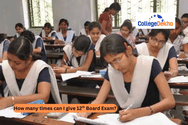
Never Miss an Exam Update
CBSE Class 12th Political Science Chapter 7 - Regional Aspirations: In CBSE Class 12th Political Science syllabus, “Regional Aspirations” discusses how Regional aspirations play an important role in the democratic system. Through the chapter, students learn about the Region and the Nation which includes Indian approach, and Areas of tension. The chapter introduces them to the Roots of the Problem, External and internal disputes, Politics since 1948, External and internal disputes, 2002 and Beyond in Jammu and Kashmir. They also get to learn about the political context, cycle of violence, and road to peace in Punjab. The chapter also includes information about the Demands for autonomy, Secessionist movements, Movements against outsiders, Sikkim’s Merger in The North East. It also provides detailed knowledge about the Accommodation and National Integration.
Following are some of the questions appearing in the board exam for different marks. Understanding the questions, students can try to give complete answers.
Q.1 - Regional aspirations of the people of the North-East get expressed in different ways. These include movements against outsiders, movement for greater autonomy and movement for separate national existence. On the map of the North-East, using different shades for these three, show the States where these expressions are prominently found.
Q.2 - Why did the Anandpur Sahib Resolution become controversial?
Q.3 - The Assam movement was a combination of cultural pride and economic backwardness. Explain.
Q.4 - What were the main provisions of the Punjab accord? In what way can they be the basis for further tensions between the Punjab and its neighbouring States?
Q.5 - Regional demands from different parts of India exemplify the principle of unity with diversity. Do you agree? Give reasons.
The students will find questions of different marks such as 1 mark, 2 marks, 4 marks, and 5 marks. According to the marks, students should add all the relevant points in the answers. They should also learn to answer map-based questions. The correct answers will help them score full marks.
Are you feeling lost and unsure about what career path to take after completing 12th standard?
Say goodbye to confusion and hello to a bright future!

Was this article helpful?


































